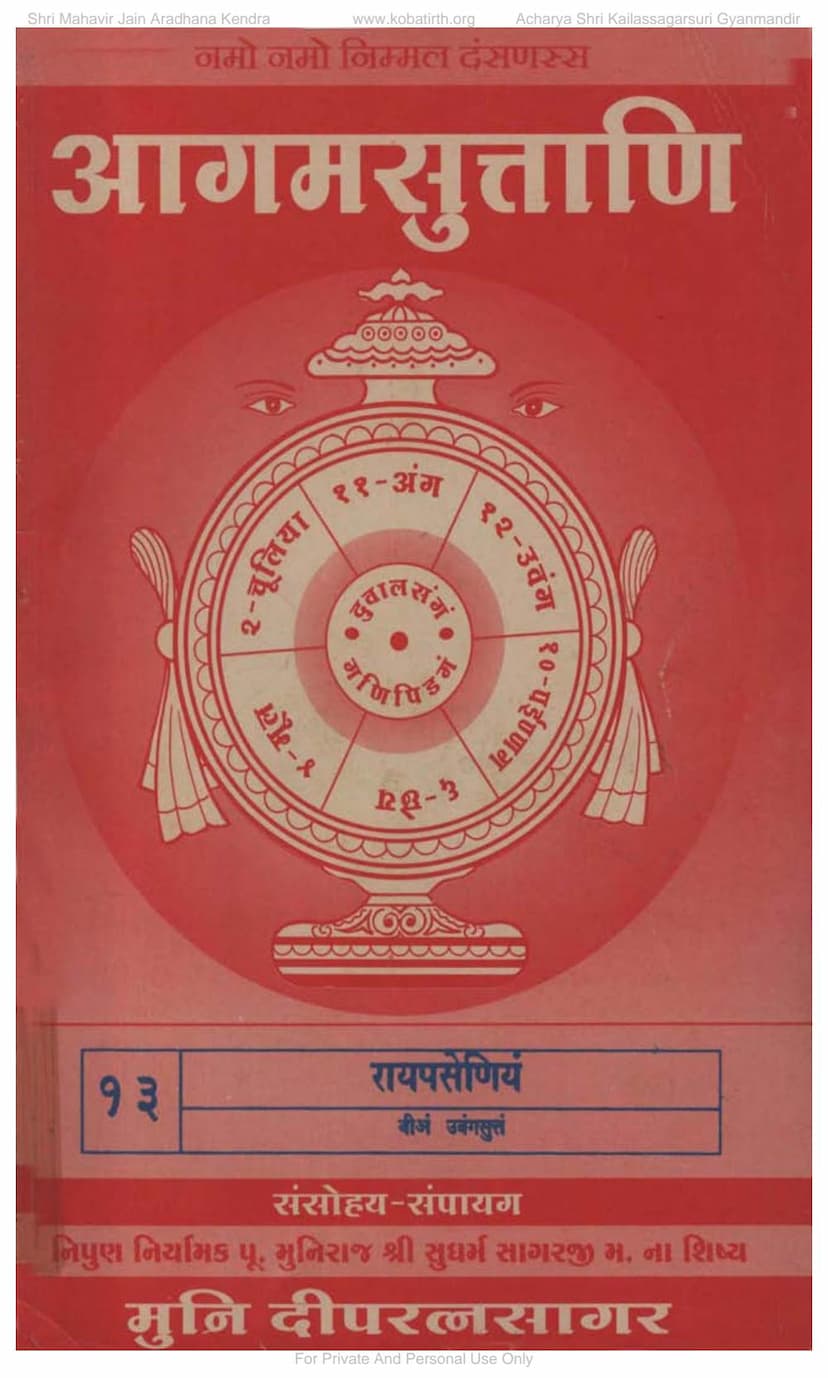Agam 13 Raipaseniyam Uvangsutt 02 Moolam
Added to library: September 1, 2025
Loading image...

Summary
The Jain text "Agam 13 Raipaseniyam Uvangsutt 02 Moolam" by Dipratnasagar and Deepratnasagar, published by Agam Shrut Prakashan, is a foundational scripture within the Jain Agamas, specifically categorized as an Upanga Sutra. This volume is part of a larger collection of Jain Agamas, with this particular text being the second Upanga Sutra.
Key Aspects and Content as indicated by the provided pages:
- Structure and Classification: The text is part of the "Agam Suttaani" (Agam Sutras), specifically numbered 13 in the context of the provided excerpt. It belongs to the "Uvanga Sutta" (Upanga Sutras) category, with this being the second such sutra. It also references other categories like Anga Sutras and Paññatti (Prakirna) Sutras, indicating its place within the comprehensive Jain canonical literature.
- Spiritual Foundation: The recurring phrase "Namo Namo Nirmal Dassanassa" (Homage to pure/spotless vision) and references to Jain Acharyas like Acharya Shri Kailassagarsuri and Muni Shri Sudharmasagarji highlight the spiritual and devotional underpinnings of this publication. The dedication to principles like "Brahma-chari Shri Neminathaya Namah" and the gurus "Shri Anand-Kshama-Lalit-Sushil-Sudharmasagar" emphasizes devotion to purity and righteous conduct.
- Philanthropic Support: A significant portion of the initial pages (pages 2-5) is dedicated to acknowledging the numerous individuals and organizations who provided financial support for the publication of the Agam set. This highlights the community-driven effort and the importance placed on making these scriptures accessible. The list of donors includes names from various cities and families, indicating broad support.
- Content Outline (Page 6): Page 6 provides an index or table of contents, outlining the structure of the text. It indicates sections like "Kam" (Karma), "Pithkō" (Pitaka), "Parisith" (Parishisht), and "Vishesh Sahānukkāyō" (Special Index of things). It also mentions indices for specific elements like "Vishesh Nāmāphukkamo" (Special Names Index), "Gāhāṇurukmo" (Verse Index), and "Suttāṇurukmo" (Sutra Index).
- Instructions for Use: Page 6 also includes important notes on how to interpret the text, such as:
- The first number on the left indicates the sequential number of the sutra and gatha.
- The Hindi number on the right indicates the sutra and gatha number within that section.
- Vertical lines indicate sutras, and the number between them is the sutra number.
- Double vertical lines indicate gathas, and the number between them is the gatha number.
- English numbers on the right indicate the commentary (vritti) number.
- Square brackets
[]denote editorial additions or clarifications.
- Textual Excerpts (Pages 7 onwards): The subsequent pages begin to present the actual text of the Raipaseniyam Sutra in Prakrit (likely Ardhamagadhi). The initial verses describe a city named Amalakappa, an Ashoka grove, and the arrival of Lord Mahavir. It details an interaction with the celestial being Suriyabha (Surya), who, impressed by the discourse of Lord Mahavir, descends to pay respects. The text then elaborates on the celestial realm, the divine beings, their palaces, and the rituals they perform. The narrative involves the celestial being Suriyabha receiving instructions from Lord Mahavir and subsequently ordering his retinue to honor the Tirthankara.
- Detailed Descriptions of Celestial Palaces and Activities: The extensive descriptions of Suriyabha's palace (Vaimānika), the various divine beings (Sāmāṇika, Agāmahiṣī, Āyarakṣa Devas), their attire, ornaments, and the grand assemblies (Sabha) suggest a rich narrative detailing celestial life and the reverence shown to enlightened beings in Jain cosmology. The intricate descriptions of musical instruments, dances, and the overall grandeur of the divine realm are characteristic of such texts.
- Thematic Focus: While the provided excerpt doesn't reveal the entire philosophical depth, the initial narrative focuses on the reverence and devotion of celestial beings towards Lord Mahavir, emphasizing the importance of virtuous conduct and spiritual attainment. The detailed descriptions of celestial abodes and rituals serve to illustrate the karmic consequences and the magnificence associated with spiritual merit.
In essence, this volume is a scholarly and devotionally supported publication of a significant Jain scriptural text, the Raipaseniyam Sutra, which likely delves into Jain cosmology, the lives of Tirthankaras, and the principles of righteous conduct as understood within the Jain tradition.